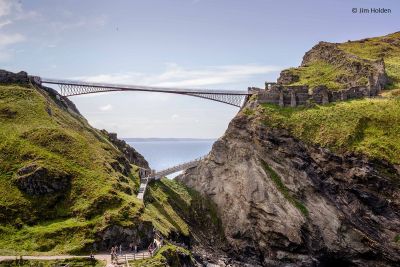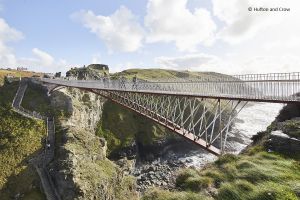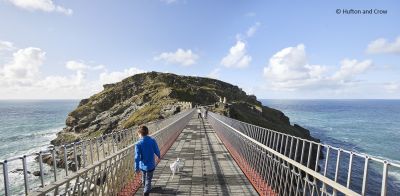Tintagel Footbridge, Cornwall
Structural Steel Design Awards 2020 - Award
Tintagel Castle is one of the UK’s most important historic sites - a Scheduled Ancient Monument, Site of Special Scientific Interest, Area of Outstanding Natural Beauty and a Special Area of Conservation. Managed by English Heritage on behalf of the Duchy of Cornwall it draws over 200,000 visitors a year and up to 3,000 a day in the peak summer season.
The Cornish name Din Tagell means literally the Fortress of the Narrow Entrance. An important trading port in the fifth to seventh centuries, it achieved international fame in the 12th Century when Geoffrey of Monmouth’s History of the Kings of Britain described it as the place of the legendary King Arthur’s conception. In 1230 this inspired Richard, Earl of Cornwall, to build a castle on the natural land bridge linking the headland (also known as the island) with the mainland. The land bridge has since eroded significantly and destroyed large parts of the castle which is now split into two and separated by a void 65m wide. For centuries visitors crossed a wooden bridge at the foot of the void and climbed a series of vertiginous steps onto the island. This restricted access for many people and caused significant congestion in the summer months, ruining the experience for many visitors.
In 2015 English Heritage held a design competition for a new bridge reconnecting the two halves of the castle allowing visitors to experience the historic approach and entrance to the castle’s inner ward. From 135 entries six teams were shortlisted, and the winner was announced in early 2016.
The design is relatively simple - two 33m-long cantilevers which reach out from each abutment and don’t quite meet in the middle. The central gap serves two functions; technically it allows each bridge half to expand and contract with variations in temperature; and poetically it creates a threshold between the mainland and the island. A series of 16m-long rock anchors tie the bridge halves into each cliff face.
The palette of materials is equally simple - painted mild steel for the main chords; duplex stainless steel for the cross bracing, deck trays and balustrading; Delabole slate laid on edge for the deck finish; and untreated English oak for the handrail. Each material was selected for its durability in an extremely harsh marine environment, and the manner in which it would weather with as little maintenance as possible. Architecturally, the aim was to create a bridge which was resolutely contemporary in its design and fabrication, but also timeless and complementary to its setting
The steel element was chosen as a [[lightweight solution, and one that can be fabricated offsite into deliverable pieces. Getting the steel elements to site was just one of the challenges that needed to be overcome, as the gatehouse can only be accessed by one narrow lane. A multi-axle vehicle was used to deliver the steelwork and navigate the winding road.
Lifting the steel into place was another significant challenge, with no room or access for a crane in the gorge, which is more than 60m-deep. A cable crane was installed, more commonly used in mountainous regions such as the Alps, to supply materials and even personnel to otherwise inaccessible locations. The cable crane had a 5-tonne lifting capacity, could pick-up steel elements from a small holding area on the headland and subsequently fed the construction of the bridge’s two cantilevers. None of the bridge’s steel elements exceeded the cable crane’s capacity, while the largest two pieces, each 10m-long × 4.5m-deep and installed at either end of the cantilevers where the structure meets the abutments, were within a size that was transportable on the access route.
All of the steel elements were fabricated into fully-assembled and erectable pieces, that included top and bottom chords, bracings and cross members. A total of six pieces were needed for each of the cantilevers. As the bridge is in a very aggressive environment with plenty of wind-borne sea salt around, mild steel was chosen for the parts which can be easily repainted and stainless steel, which is more resistant to corrosion, for the areas where painting would be more difficult.
The connection points between each individual steel assemblage (two on each piece) are also were fabricated from stainless steel and were welded to the main chord members during the fabrication stage. The connections consist of finger joints that interlock with opposite members on the adjoining section, similar to a woodwork dovetail joint. Once the individual sections were lifted and manoeuvred into place during the erection programme, the connections were then bolted up. The fabrication process required some precise engineering and each section was trial erected with its neighbouring piece to ensure the two cantilevers could be seamlessly erected on-site.
Construction started in September 2018 and was completed in August 2019.
Further details of the design and construction of this project are available here.
| Lead Architect | Ney & Partners |
| Co Architect | William Matthews Associates |
| Steelwork Contractor | Underhill Engineering Limited |
| Main Contractor | American Bridge UK |
| Client | English Heritage |
Judges' comment
A highly crafted and timeless structure: daring in its concept yet modest and sympathetic to its historic and natural context. Every steel component has been carefully detailed for constructability and durability, elevating the graceful aesthetic. The project is a triumph: a credit to English Heritage’s vision and the entire team which employed mostly local fabricators, supported by alpine construction specialists.






